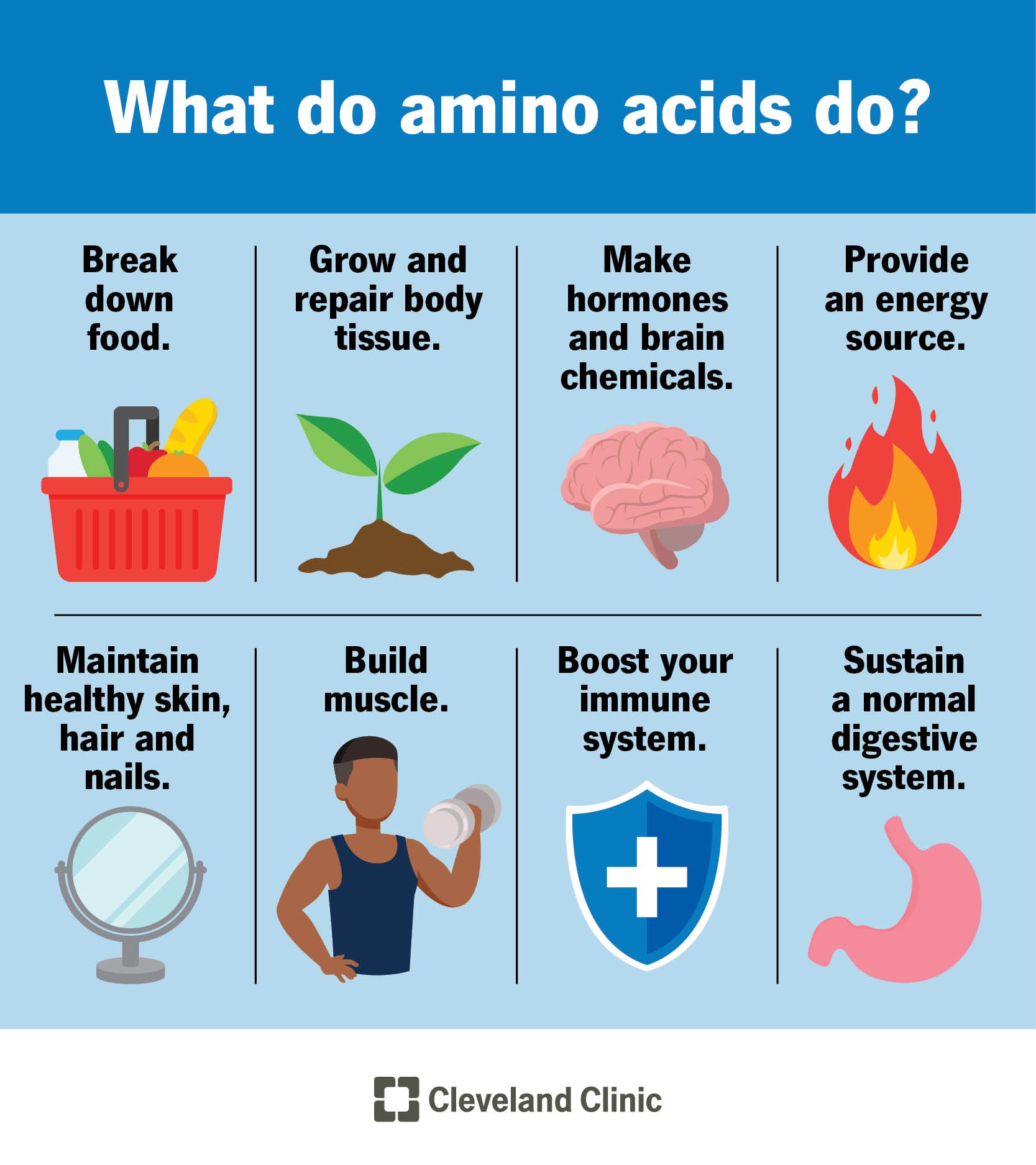Amino acids are molecules used by all living things to make proteins. Your body needs 20 different amino acids to function correctly. Nine of these amino acids are called essential amino acids. Essential amino acids must be consumed through the food you eat. Essential amino acids can be found in a variety of foods, including beef, eggs and dairy.

Amino acids are the building blocks of protein. Proteins are long chains of amino acids. Your body has thousands of different proteins that each have important jobs. Each protein has its own sequence of amino acids. The sequence makes the protein take different shapes and have different functions in your body.
You can think of amino acids like the letters of the alphabet. When you combine letters in various ways, you make different words. The same goes for amino acids — when you combine them in various ways, you make different proteins.
Cleveland Clinic is a non-profit academic medical center. Advertising on our site helps support our mission. We do not endorse non-Cleveland Clinic products or services. Policy
Your body needs 20 different kinds of amino acids to function correctly. These 20 amino acids combine in different ways to make proteins in your body.
Your body makes hundreds of amino acids, but it can’t make nine of the amino acids you need. These are called essential amino acids. You must get them from the food you eat. The nine essential amino acids are:
Your body produces the rest of the 11 amino acids you need. These are called nonessential amino acids. The nonessential amino acids are alanine, arginine, asparagine, aspartic acid, cysteine, glutamic acid, glutamine, glycine, proline, serine and tyrosine.
Some nonessential amino acids are classified as conditional. This means they’re only considered essential when you’re ill or stressed. Conditional amino acids include arginine, cysteine, glutamine, tyrosine, glycine, ornithine, proline and serine.
An amino acid is an organic chemical. Organic chemicals contain carbon-hydrogen bonds. All amino acids have the same basic structure. Each molecule has a central carbon atom linked together with a basic amino group, a carboxylic acid group, a hydrogen atom and an R-group, or side-chain group. The R-group is what sets the amino acids apart. The R-group determines each amino acid’s chemical nature. The chemical nature controls how it’ll interact with other amino acids and its environment.
The amino acids link together with peptide bonds and become proteins. Then, the forces of other amino acids and the effects of their R-groups fold the protein into specific three-dimensional shapes.
Your body uses amino acids to make proteins. The different types of amino acids and the way they’re put together determine the function of each protein. So, amino acids are involved in many important roles in your body. Amino acids help:
You don’t need to eat foods with amino acids at every meal, but it’s important to get a balance of them throughout your day. The recommended daily allowance for every 2.2 pounds of body weight for each of the essential amino acids are:
Essential amino acids can be found in many different foods. The best sources of amino acids are found in animal proteins such as beef, poultry and eggs. Animal proteins are the most easily absorbed and used by your body.
Foods that contain all nine essential amino acids are called complete proteins. These foods include beef, poultry, fish, eggs, dairy, soy, quinoa and buckwheat.
Foods that contain some but not all the essential amino acids are called incomplete proteins. These foods include nuts, seeds, beans and some grains. If you follow a vegetarian or vegan diet, you need to include several types of incomplete proteins in order to ensure you’re consuming all nine essential amino acids.
You can usually get all the essential amino acids your body needs by eating a healthy, balanced diet. Some people take amino acid supplements to get better sleep, improve their mood and enhance athletic performance. But the U.S. Food and Drug Administration (FDA) has not approved these supplements. You should speak with your healthcare provider before starting any supplements, including amino acid supplements.
A note from Cleveland Clinic
Amino acids are the building blocks of proteins. They are the molecules that all living things need to make protein, and you need 20 of them to help your body function properly. Your body makes 11 of the necessary amino acids. The good news is you don’t have to do anything special to get the remaining nine amino acids your body needs. You just need to eat a balanced diet. Focus on complete proteins — foods that contain all nine essential amino acids, such as meat, eggs and dairy. Incomplete proteins such as nuts and beans are good, too. Talk to your healthcare provider if you need help or suggestions on getting enough amino acids in your diet.
Last reviewed by a Cleveland Clinic medical professional on 12/22/2021.
Learn more about our editorial process.
Cleveland Clinic is a non-profit academic medical center. Advertising on our site helps support our mission. We do not endorse non-Cleveland Clinic products or services. Policy